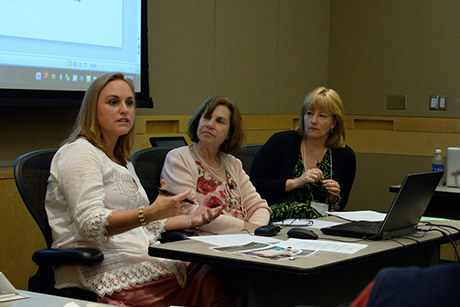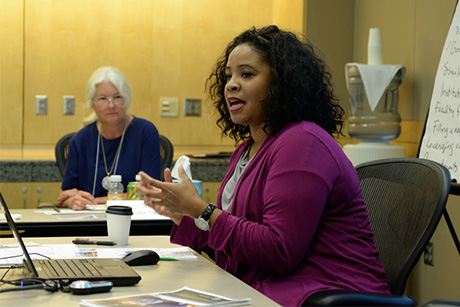By Sara Birmingham
Reprinted from Cornell Chronicle, July 2, 2014

Janis Whitlock, BCTR research scientist; Denyse Variano, family and consumer sciences issue leader, CCE Orange County; and Suzan Sussmann, parenting educator, CCE Orange County discuss their partnership to create support groups and educational materials for teens who self-injure. Photo by Mark Vorreuter
When Natalie Bazarova, Cornell assistant professor of communication, wanted to study how and what people share on social networks, she turned to experts on the ground – Cornell Cooperative Extension parent educators – to connect with local families. Not only did these practitioners shape her research design, Bazarova said, at project’s end she had a network of partners to help “increase social media literacy and Internet competency in local communities.”

Tasha Lewis, assistant professor of fiber science and apparel design, presents her research priorities to the group. Photo by Mark Vorreuter
At the Research Navigator Initiative workshop on campus June 25-26, Bazarova and nine other faculty members joined 19 extension educators from eight counties to explore how to broaden pathways between research and the real world. The Bronfenbrenner Center for Translational Research (BCTR), part of the College of Human Ecology, sponsors the trainings to bridge the “two cultures” of research and practice, according to Karl Pillemer, the Hazel E. Reed Professor of Human Development, who helped found the workshops, which have reached 100 CCE educators and executive directors since 2010.
“There are tremendous benefits for both our researchers and outreach specialists from working together,” Pillemer said. “Researchers can ground their studies in the real-world experience of extension educators, and field staff participate in creating new knowledge that they can use in their daily work in communities.”
Jennifer Tiffany, Ph.D. ’04, executive director of CCE New York City, BCTR director of outreach and community engagement, and CCE associate director, called the workshop “a think-tank type context, in which we all could work creatively on developing more systematic, bidirectional translational research practices.”
Throughout the workshop, researchers and practitioners repeated a common goal: to initiate ground-up projects driven by community needs as well as more traditional top-down research originating from campus. “We usually see things as flowing from the research to the practice,” said John Eckenrode, BCTR director and professor of human development. “We want to reverse the arrows.”
At a panel discussion, CCE Orange County educators Denyse Variano and Suzan Sussmann and BCTR research scientist Janis Whitlock demonstrated a successful research-practice partnership. Three years ago, after a presentation by Whitlock about her findings on adolescent self-injury, Variano and Sussmann reached out to her for help educating families about the issue. The partnership has led to continuing programming on nonsuicidal self-injury, including support groups and educational outreach.
Such successes demonstrate the ability of campus researchers and community practitioners to bridge the gap between their worlds, Pillemer said. “We try to put into practice something that is often discussed, but less frequently acted on: connecting scientists on campus with community partners to conduct research that is truly relevant to practice needs,” Pillemer said.
Faculty presenters included Tasha Lewis, Ph.D. ’09, assistant professor of fiber science and apparel design; Carol Devine, Ph.D. ’90, professor of nutritional sciences; and Marianella Casasola, associate professor of human development.
Sara Birmingham ’15 is a student communications assistant for the College of Human Ecology.
Related Links:
College of Human Ecology
Bronfenbrenner Center for Translational Research
Translational Research Tools

